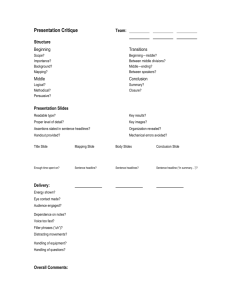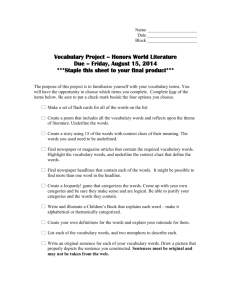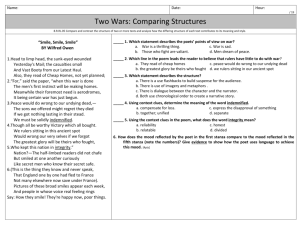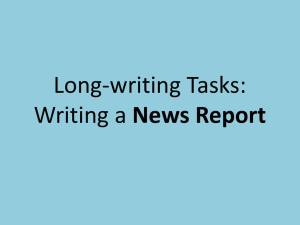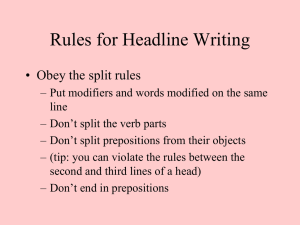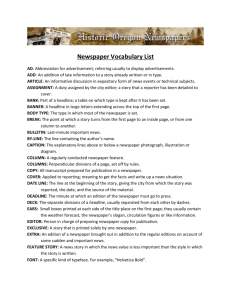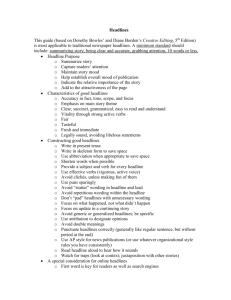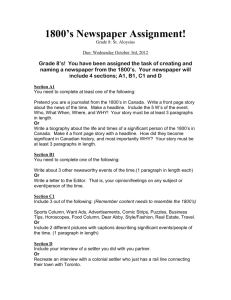THE LANGUAGE OF NEWSPAPERS
advertisement
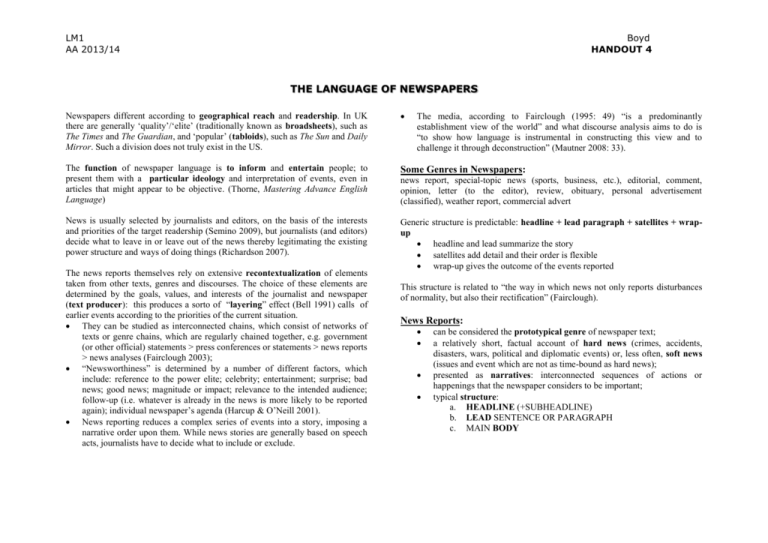
LM1 AA 2013/14 Boyd HANDOUT 4 THE LANGUAGE OF NEWSPAPERS Newspapers different according to geographical reach and readership. In UK there are generally ‘quality’/‘elite’ (traditionally known as broadsheets), such as The Times and The Guardian, and ‘popular’ (tabloids), such as The Sun and Daily Mirror. Such a division does not truly exist in the US. The function of newspaper language is to inform and entertain people; to present them with a particular ideology and interpretation of events, even in articles that might appear to be objective. (Thorne, Mastering Advance English Language) Some Genres in Newspapers: News is usually selected by journalists and editors, on the basis of the interests and priorities of the target readership (Semino 2009), but journalists (and editors) decide what to leave in or leave out of the news thereby legitimating the existing power structure and ways of doing things (Richardson 2007). Generic structure is predictable: headline + lead paragraph + satellites + wrapup headline and lead summarize the story satellites add detail and their order is flexible wrap-up gives the outcome of the events reported The news reports themselves rely on extensive recontextualization of elements taken from other texts, genres and discourses. The choice of these elements are determined by the goals, values, and interests of the journalist and newspaper (text producer): this produces a sorto of “layering” effect (Bell 1991) calls of earlier events according to the priorities of the current situation. They can be studied as interconnected chains, which consist of networks of texts or genre chains, which are regularly chained together, e.g. government (or other official) statements > press conferences or statements > news reports > news analyses (Fairclough 2003); “Newsworthiness” is determined by a number of different factors, which include: reference to the power elite; celebrity; entertainment; surprise; bad news; good news; magnitude or impact; relevance to the intended audience; follow-up (i.e. whatever is already in the news is more likely to be reported again); individual newspaper’s agenda (Harcup & O’Neill 2001). News reporting reduces a complex series of events into a story, imposing a narrative order upon them. While news stories are generally based on speech acts, journalists have to decide what to include or exclude. The media, according to Fairclough (1995: 49) “is a predominantly establishment view of the world” and what discourse analysis aims to do is “to show how language is instrumental in constructing this view and to challenge it through deconstruction” (Mautner 2008: 33). news report, special-topic news (sports, business, etc.), editorial, comment, opinion, letter (to the editor), review, obituary, personal advertisement (classified), weather report, commercial advert This structure is related to “the way in which news not only reports disturbances of normality, but also their rectification” (Fairclough). News Reports: can be considered the prototypical genre of newspaper text; a relatively short, factual account of hard news (crimes, accidents, disasters, wars, political and diplomatic events) or, less often, soft news (issues and event which are not as time-bound as hard news); presented as narratives: interconnected sequences of actions or happenings that the newspaper considers to be important; typical structure: a. HEADLINE (+SUBHEADLINE) b. LEAD SENTENCE OR PARAGRAPH c. MAIN BODY LM1 AA 2013/14 Headlines have three main functions, but in a limited amount of space (which explains their peculiar characteristics): 1. 2. 3. to attract potential readers to indicate the topic of the story (often with a small summary) to provide the approach that will be taken to the relative event reported, in terms of tone, evaluation, ideological slant, etc. Boyd HANDOUT 4 Main Body Some characteristics of headlines: graphologically larger; grammatical “simplifications” as in other forms of “block language” (notices, titles, adverts, slogans, etc.), which can create a “telegraphic” effect: o article o copular/auxiliary verbs o connective o possessive lexis is relatively short and dramatic, which combine brevity with effectiveness; stylistic and rhetorical devices are used to attract and intrigue readers: o puns and word play o alliteration, rhyme or other play on sound o metaphor o proverbs o intertextuality o loaded language (e.g. “butchered”) o grammatical class shift (e.g. verb > noun) Many of these characteristics can be seen in Italian headlines, though not always to the same extent and there are some main differences: the headlining is more elaborate in Italian consisting of a pre-headline (occhiello), a headline proper and a sub-headline. The Italian headlining system allows more room for directly quoting direct or indirect speech. (Taylor, Language to Language). Lead provides the ‘micro-story’ (Bell 1991: 170), which is the gist of the issues or events. This may include the 5 Ws (Who, What, Where, When, Why) + H (How) Often written in a different font or in bold (especially in the popular press) Inverted-Pyramid Structure: the most important items of information in any newspaper report are presented first, at the top of the “pyramid”, in the various headlines, lead and in the opening sentences of the text. This structure has implications on the THEME/RHEME structure of the journalistic text. Rather than referring back to the previous sentence, clauses in the text refer back directly to the headline and lead, thus creating a HYPERTHEME. Some other linguistic means which are important in the presentation of people and events are presented, evaluated and, in some cases, obscured: o use of noun phrases or labelling of news actors to refer to people and groups: rebels vs. resistance fighters o use of lexis with a strong evaluative meaning o use of different types of verbs to refer to actions and events: protesting vs. rioting o use of nominalization (i.e. using a noun instead of a verb to refer to actions and events), which allows the omission of the main agent: the killing of a Palestinian child o transitivity (how events are described): who does what to whom and what happens without intervention from actors. There are four different process types: verbal (saying), mental (sensing), relational (being) and material (doing: the actor is the one that does the deed) (Mautner 2008: 41) o use of passive voice, which also allows for the omission of the agent: a Palestinian child was killed o use of modality or the way language shows degrees of certainty and commitment and/or vagueness: modal verbs (can, might, must), modal adverbs (perhaps, certainly), o use of metaphorical expressions to describe one thing in terms of another: a flood of immigrants o use of figures to back up claims o use of vagueness and exaggerated expressions LM1 AA 2013/14 o o Boyd HANDOUT 4 presentation of speech in various ways: narrator, narrator’s presentation of speech acts, indirect speech, direct speech, rhetorical questions use of strategies to avoid identifying with precision the person or people whose words are being presented: passive voice: is said to be nominalization: allegations that metaphorical: source metonymy: Britain for some unspecified members of the British government Analyze the following headlines: 1. CHANNEL RAIL LINK DECISION THIS WEEK 2. MOTHER TELLS OF BABY’S DEATH AT HOSPITAL 3. LOBBYISTS FIGHT EFFORTS TO SAVE ON HEALTH CARE 4. MAN JAILED FOR ALLOWING GIRL, 3, TO SMOKE 5. MP 'DEEPLY HURT' AT PAPER'S EXPENSE CLAIMS 6. MY TWISTED LIFE AS OSAMA’S WIFE: MARRIED TO A MONSTER 7. LOUT1 OF ORDER: FURY AS TEEN URINATES ON WAR MEMORIAL 8. OBAMA IN BIND TRYING TO KEEP HEALTH LAW VOW 9. SUPER CALLY GO BALLISTIC CELTIC ARE ATROCIOUS 10. RED TAPE HOLDS UP NEW BRIDGE 11. LUNG CANCER IN WOMEN MUSHROOMS 12. KNICKS TAKE A STEPH BACK 13. JACKPOT BRO KEEPS THE DOUGH 1 uncouth or aggressive man or boy 14. SIGNED, SEALED AND UNDELIVERED 15. DELAY ELECTIONS, SAY EGYPT PROTESTERS 16. POLAND’S ECONOMY FALLS FROM PEDESTAL 17. CITY OF DESPAIR AND DECAY 18. EUROBONDS PLAN SPARKS EU STORM 19. UN CHIEF SLAMS CLIMATE TREATY DELAY 20. CHINESE LEADER GETS MORE SWAY ON THE ECONOMY AND SECURITY
